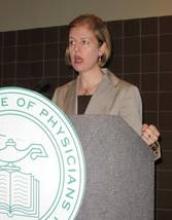Red flags in the history include a myocardial infarction, a stroke, traumatic brain injury due to a fall, seizures, the use of medications known to impair driving, and delirium.
"Development of delirium during a hospitalization is a sign that there’s actually some underlying cognitive impairment that hasn’t been recognized yet," according to Dr. Day.
Her preliminary screen for driving safety routinely includes the "10 Questions to Ask the Patient" described in the American Medical Association’s very useful "Physician's Guide to Assessing and Counseling Older Drivers." Among the 10 questions are, for example, " ‘Have you received any traffic citations for speeding, going too slow, improper turns, failure to stop, etc.?’ " and " ‘Have others criticized your driving or refused to drive with you?’ " she said. Patients can fill out the answers on a clipboard while in the waiting room.
Many patients will quickly see where these questions are headed and won’t answer honestly. That’s why the AMA also has come up with "10 Questions to Ask the Family." Among them are " ‘Does the patient need a copilot to alert them of potentially hazardous events or conditions?’ " and " ‘Do you feel uncomfortable in any way driving with the patient?’ " Dr. Day said.
"That’s a great question to ask the children because if they’re not letting the grandchildren drive with grandma or grandpa, there’s a problem," she said.
Driver rehabilitation options include occupational therapy to address mobility limitations, instruction by a member of the Association for Driver Rehabilitation Specialists, local driving schools, and training courses offered by the American Association of Retired Persons, the American Automobile Association, and the National Safety Council.
But when it really is time to stop driving altogether, Dr. Day said she speaks to the patient of "driving retirement," akin to the familiar milestone experience of retirement from work. She also plays the public safety card, asking, " ‘Would you want to hit someone’s child?’ " And since she is in Pennsylvania, a mandatory reporting state, she mentions her own responsibility.
"I work that," she admitted. "I say, ‘Look, my license is on the line. I have to report you.’ "
One audience member, noting that driving cessation conversations are "often very tense," likes to lighten things up a bit in the following way: "I tell patients there are three categories of recommendations for driving: One is you can drive. Two is you cannot drive. And the third is you can drive, but not in my neighborhood."
Dr. Day said an important part of preparing for the aftermath of not driving involves alerting patients to local resources that will help them get around without driving. Eldercare Locator is a U.S. Administration on Aging clearinghouse for local van services for the elderly and numerous other resources. The National Association of Area Agencies on Aging is another helpful organization. ITN America is a growing nonprofit volunteer organization of screened drivers available around the clock to drive patients.
She stressed that it’s crucial to monitor for depression at the next office visit after a patient stops driving. Giving up the car keys is often a big blow to self-esteem, and it can reduce opportunities to engage in social activities.
Dr. Day reported having no relevant financial conflicts.


